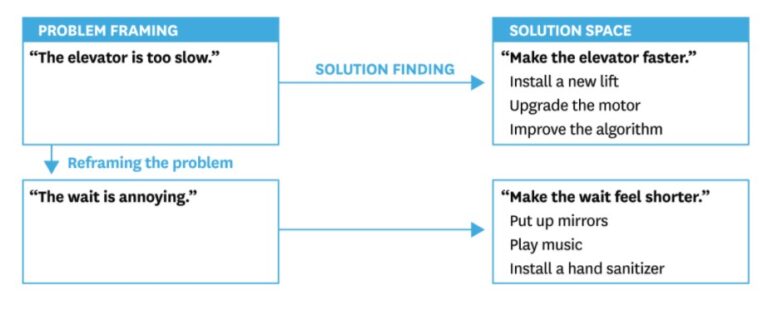"As Peter Drucker pointed out, there’s nothing more dangerous than the right answer to the wrong question. There is a way to do better. The key is reframing, a crucial, underutilized skill that you can master with the help of the book "What's Your Problem?..." - Amazon.com
Frame the Problem
- What is the problem we are trying to solve?
- Don’t accept the problem statement at face value. Ask:
- Is the statement true?
- Are there self-imposed limitations?
- Is a solution "baked into" the problem framing?
- Is the problem clear?
- With whom is the problem located?
- Are there strong emotions?
- Are there false trade-offs?
Look Outside the Frame
- What are we missing?
- Avoid delving into the details of the issue you face. Zoom out. Ask:
- What's missing from the current problem statement?
- Are there elements we're not considering?
- Is there anything outside the frame that we're not currently paying attention to?
- Look beyond your own expertise, and hidden influences, and consider causal events prior to the situation.
Rethink the Goal
- Is there a better objective to pursue?
- As we focus on the problem and how to solve it, it “prevents us from questioning a more important thing: the goal we’re trying to reach.”
Examine Bright Spots
- Where is the problem not?
- "Look for situations or places where the problem is not as bad, or where it may even be entirely absent. Paying attention to such positive exceptions can give you a new perspective on the problem, and may even point you directly to a viable solution."
Look in the Mirror
- What is my/our role in creating this problem?
- "Even if you don’t contribute to the problem, ask whether you can react differently to it.”
Take Their Perspective
- What is their problem?
- "Discovering how others see the world—and in particular, how they see it differently from you—is perhaps the most fundamental form of reframing there is."
- Try to disregard your own preferences. Focus only on how they might feel and think.
Move Forward
- How can I validate my/our framing of the problem through real-world testing?
- After you have reframed the problem, test it out to see if you are, in fact, targeting the right problem. You may have a number of reframed problems at the end of this process. In that case, narrow them down by looking for surprising, simple, r significant-if-true framings.
The Seven Practices for Effective Reframing
- Establish legitimacy – It is difficult to use reframing if you are the only person in the room who understands the method. Show them this article, or relate the slow elevator problem and solution.
- Bring outsiders into the discussion – This is the single most helpful reframe practice. Search for people who understand but are not entirely in your world, and who can speak freely. Don’t expect solutions, but instead, input.
- Get people’s definitions in writing – People commonly leave a meeting believing they all agree with something just to find out months later that they actually had different views. Writing it down can help define differences and look contrarily at the problem
- Ask what’s missing – When facing a problem description, we tend to go deep into the details of what has been stated, perhaps overlooking what has been missed.
- Consider multiple categories – Transforming people’s perception of the problem can bring powerful changes. One method is inviting people to specify which category of the problem they are facing. Is it a motivation problem? A quality problem? An attitude problem? Then try to suggest more categories.
- Analyze positive exceptions – You can look for new insights and try to find instances when the problem did not occur: “What was different about that situation?“
- Question the objective – You can reframe a problem by clarifying and challenging the objectives of all involved parties. The slow elevator problem shows us an objective change from making the elevator faster to improving the waiting time experience.
.png)

0 Comments:
Post a Comment